4 - Human capital for growth in Europe
In 2005 the European Commission relaunched the Lisbon strategy, centring action principally on the realization of more stable and lasting growth and on the creation of new and better jobs. Growth and employment must always go hand in hand. For Europe this means that growth without job creation must be avoided, because the long term objective is to improve the quality of life of all citizens in a context of greater prosperity and social justice. On the other hand an increase in employment positively influences the pace of growth and consequently contributes to making the European Union more competitive in the global market. It is therefore indispensable to increase efforts to offer new and better jobs to citizens through targeted and active policies as well as adequate incentives.
In the context of our fast-paced economic change and rapid aging of the population, the creation of new jobs becomes an economic and social necessity. The continuing decrease in the active population, alongside the increase in the elderly, puts great pressure on the pension and insurance systems and, without corrective measures, will lead to a reduction in potential growth. Therefore, a larger number of people has to be attracted to and kept in the labour market through adequate policies both for young people and older workers. These policies should offer incentives to the latter to remain active longer and to dissuade them from retiring from work too early, fully exploit the enormous potential that women represent, help the unemployed and re-integrate the non-working and the least advantaged population into the working world.
The Italian government counts on the quality of jobs to increase the percentage of economically active population and to make employment more attractive and remunerative, while, among other things, struggling against the growing precariousness of the labour market. In the first annual report on the implementation of the national reform programme, the government highlights the importance of policies meant to reconcile work and caring for a family, their impact on youth and female employment, action directed towards promoting greater social equity, towards the elimination of regional disparities and the protection of the weaker strata, and investing more in the systems of education and training.
 Greater employment Greater employment
In 2006, demand for labour in Italy grew at a pace that had not been registered for some time, employment increased by nearly 2%, i.e. 425,000 more jobs than in 2005. Once again, a relevant contribution came from the foreign population, which made up 42% of the total newly employed, and from temporary positions.
Even if there was a continuous increase in the level of employment in the Veneto, with nearly 2% more workers compared to the previous year and well over 18% more if compared to 1995, the increase is not as considerable as in other northern regions, such as Friuli-Venezia Giulia, Liguria and Emilia-Romagna, which recorded a growth of 3%, 2.7% and 2.5% respectively, even if in the first two regions mentioned the employment situation is still less favourable than in Veneto.
Both Italy and the Veneto are witnessing a considerable increase in the employment rate, indeed, since 2003 such a high yearly increase has not been seen. On the national level in 2006 the employment rate was 58.4% compared to 57.5% the previous year, while in the Veneto region, which has always had a significantly higher level of employment, the share of the economically active population between 15 and 64 was 65.5%, as opposed to 64.6% in 2005. Despite the employment growth, the European objective established by the Lisbon strategy to achieve a median employment level of 70% by 2010 still seems distant. However, the prospects for the region will be better if it can maintain last year's positive trend in the population employed also over the next few years. Furthermore, the Veneto is among the economically leading regions which are characterized in particular by a high level of employment (above 65%). In the Veneto this rate has been growing also in the last two years. If the employment rate in 2006 is considered, the Veneto is placed fifth in the regional standings, only significantly behind Emilia-Romagna (69.4%), the Italian region which is first in the rankings and which has practically achieved the employment objective (Figure 4.1).
At the same time in 2006, along with the considerable increase in employment, in Italy was observed a significant decrease in persons looking for work, namely over 11% less than the year before. The unemployment rate dropped to 6.8% as opposed to 7.7% in 2005, recording the lowest rate of the last decade. The reduction occurred principally in the South where both males and, to a greater extent, females were involved. The unemployment rate also fell in the Veneto. With a figure of 4% compared to 4.2% in the previous year, the region still occupies a privileged position among the regions of Italy, tied for sixth in the regional standings with Piemonte.
The trend in the employment and unemployment rates in the Veneto are summarized by the rise in the rate of participation in the labour market which has reached 68.3% for people between age 15 and 64, nearly a percentage point higher than the year before; the participation of the Veneto's population in the work force is greater and growing more rapidly than at the national level, which recorded an overall activity rate of 62.7% (Figure 4.2)
Female employment
One of the elements that explain this flourishing labour market is the rise in the employment of women that is taking place not only in Northern and Central Italy, but also very significantly in the southern regions.
The employment rate of Italian women aged 15-64 has increased on average by one percentage point compared to the preceding year, and at a rate nearly double that of the growth for men, and has reached 46.3% in 2006. Emilia-Romagna is still the region with the highest female employment rate, already 61 women out of 100 work as opposed to 54 in the Veneto. Despite the increase in the participation of women in the labour market, achieving the Lisbon objective, which aims at an average of at least 60% of employed women in the EU by 2010, is still a very distant goal.
In 2005 the average female employment of the EU25 was, with 56 women out of 100, already closer to the target than Italy. Even if three new jobs out of four in the EU seemed to be taken by women, there are still great gender imbalances, and there are still many barriers that impede women from making their full potential felt, despite the fact that the greater participation of women in the labour market is an essential element for achieving the economic objectives (Figure 4.3).
Youth
The European strategy promotes a conception of labour based on the life cycle, with attention given to all its phases from youth to the oldest workers.
The future of Europe is bound closely to its youth, to its ability to appreciate their potential and to guarantee them opportunities for personal and professional growth. To face these challenges the European Council, on the occasion of the relaunching of the Lisbon strategy, adopted the European Youth Pact that foresees and promotes a series of coordinated initiatives in various sectors for an effective and sustainable strategy favouring youth. The Pact is intended to reduce youth unemployment and to ease their entry into the labour force, improving education and training, favouring mobility, professional assimilation and social inclusion.
The situation of youth in the labour market on the European level, however, is worrying. The phenomenon of youth unemployment in recent years has worsened and the rate in the Union of 25 countries reached 18.7% in 2005, more than double the indicator of overall unemployment. In Italy the rate was yet higher for the same year: 24 out of 100 young people between the age of 15 and 24 of the corresponding labour force were looking for work, fortunately it decreased in 2006 when the rate did not reach 22%. The figures in the Veneto are still much lower than the national average with 11.8% unemployed youth in 2006, a percentage which is also lower than in the preceding year.
While these figures bring into focus the challenges of today, demographic aging adds problematic issues for tomorrow. From today to 2050 the number of European youth is likely to decrease by a quarter, while the elderly will increase greatly. In addition the population in the 15-64 age group, i.e. the potential labour force, will decrease by one sixth, so contributing to the creation of a series of problems for the potential growth of the GDP. In line with these changes, Italy as well as the Veneto foresee an even greater decrease in the active population according to their replacement indices, by 2020 in Veneto the estimate that people ready to leave the labour market will exceed by 43% those between 15-19, who are the potential entrants.
Elderly workers and the aging active population
Elderly workers make up a considerable part of the active population. Given their potential economic production it has become essential for member states to reinforce their efforts to modify the tax and insurance system, to promote incentives to encourage the prolongation of the active labour life and to favour measures such as phased retirement and part-time work. People with children, indeed, are not the only ones who need to be offered greater flexibility at work. It can be advantageous for elderly workers as well, if they are interested in continuing to work and at the same time want to enjoy more free time as a result of partial retirement. Furthermore, it is necessary to invest in a better quality of work of older labourers, especially by offering them appropriate training, which will then lead to improved skills with advantages both for workers and firms.
In order to stimulate economic growth and consolidate the stability of public finance early retirement needs to be discouraged. On the other hand improved health cannot but lead to improved productivity. This is a hard challenge in which we must invest heavily, especially in the light of the still lower employment rates of workers between 55 and 64 recorded in 2006 in several European countries. These low rates probably reflect the privileges conceded by today's pension systems to one generation of workers at the expense of future generations.
In general, the employment rate of elderly workers in the EU25 has been increasing for years. It is still below the objective established by the European Council in Stockholm of at least 50% by 2010 but the forecast for 2006 predicts a figure a bit less than 44%. This is a rather rapid increase so that it can be conjectured that there is a good possibility of getting close to the target by the set date. The situation is worse in Italy, where the indicator in 2006 was almost 12 percentage points below the European average although the trend in the employment of older workers has been confirmed. The Veneto figure was still lower, only slightly more than half of the target (28.2%). On the other hand the position of some European areas is already quite good: in 2005 Baden-Württemberg and Bavaria the objective has already been reached (52.1% and 49.7% respectively) and Catalonia recorded a rate of 48.6% (Figure 4.4).
Foreign workers
Among the policies promoted in the programme of national reforms, there is also the intention to favour the integration of legal immigrants within the society by supporting access to citizenship, the unification of families, greater employment and housing stability. Legal migration, indeed, plays a very important role: immigrants perform tradition jobs that are still fundamental, but which are low-skilled jobs and unattractive for Italian workers. Thus foreign workers compensate the lack of certain roles in some segments of the labour market.
In Italy the demographic imbalance in the economically active population, especially in the younger segments, is the reason for the demand for immigrants. The Veneto is one of those Italian regions with the highest percentage of foreign population. The immigration is wide-spread over the whole region, especially in suburban areas and in small and medium-sized communities, where the manufacturing firms of the Veneto need workers that cannot be found among Italian citizens. In 2005 there were 143,000 foreign workers residing in the region, which amounts to 7% of the employed population. Most of the foreign workers are employees with open-ended contracts, mostly doing hard physical work in the field of industry, although it turns out clearly that, comparing them to Italian workers, their share of fixed-term contracts is higher than that of Italians. The men are more involved in the labour market than the women which is true for Italians as well: 80% of foreign males between the age of 15 and 64 are employed, as opposed to 51% of the females. The unemployment rate, however, is quite high for foreigners, 12.4% as opposed to 3.6% for the rest of the population. This is probably due to several factors, such as the economic stagnation in recent years or the "supply shock" following Italy's efforts to regularise the immigrant population in 2002, when part of the foreign workers were involved in short-term positions or "false" contracts, often concluded to allow them to regularise their stay and ended once the permit was granted.
 Employment quality Employment quality
Promoting employment is already a considerable challenge, but it is even more difficult to improve "the quality of work". Again in the spring of 2007, the European Council underlined the importance of the quality of employment and the principles that underlie it: the rights of workers, equal opportunity, adequate compensation according to productivity, continuous training, safety and protection of health in the workplace, as well as the creation of work conditions that are more favourable to family life.
"Flexicurity" and continuous training
To create and to guarantee top quality work, firms and workers must first demonstrate a greater ability to anticipate, provoke and absorb the changes and the restructuring demanded by a knowledge based economy. This provides for the redistribution of resources in favour of the most competitive sectors and jobs in Europe in a context of opening up to international markets. Workers are asked to have a greater propensity towards mobility and flexibility in order to adapt to the new needs of firms. At the same time, all possible measures have to be adopted to guarantee greater job security by reducing their vulnerability with regard to the insecurity of labour markets, to favour the workers' possibilities to improve their professional level and, consequently, to achieve an adequate increase in wages. To this end, a central role is given to continuous training that should be available to everyone, since it should enable workers to deal with rapid changes, with periods of unemployment and with transition to new employment. Particular attention should be given to the fact that less qualified workers, personnel of small and medium sized firms and workers over the age of 45 must gain access to lifelong learning.
In addition, lifelong learning is essential not only to increase competitiveness, employability and economic prosperity, but it is also a useful tool for social inclusion, an active citizenry and personal realization. The updating and improvement of skills of adults is measured by the European Council with a parameter that calls for a percentage of 12.5% of the population aged 25-64 to participate in permanent learning by 2010. In 2005, the EU25 was a bit above 10%, nearly three percentage points more than the figure five years earlier, in 2006 Italy and the Veneto were lower with a rate of 6.9% and 7.3% respectively. The performance of the northern countries was very good because five years before the date established for reaching the objective, they already find themselves well above the target: first is Sweden, where 32% of the population aged 25-64 claim to attend an educational course or professional training, followed by the United Kingdom and Denmark with over 27%. In Italy the regions of Lazio and Trentino - Alto Adige rank first, both with a percentage of 8.4% (Figure 4.5).
For full participation in permanent learning over the whole of one's life span and for professional growth, it is indispensable to have adequate basic preparation, that is, to have completed an upper secondary school at least. However, Europe's educational level is still far away from being able to guarantee the skills demanded by the labour market and from producing the new knowledge that has to spread out over the whole economy. The second objective agreed to in Lisbon established that by 2010 at least 85% of young people should complete at least an upper secondary education, but in 2005 the percentage of the population aged 20-24 possessing at least an upper secondary diploma in the EU25 was only 77.5%, roughly one percentage point more than in 2000. In Italy the situation is even worse, even if in one year an increase of nearly two percentage points was seen. In 2006 Italy still ranked below the European average with 75%. On the other hand the situation in the Veneto is considerably better, and it even recovers steadily: in the last year the region recorded a rate of 81.6%, nearly five percentage points higher than the 2005 figure.
In the light of what has just been said, the Regione Veneto and especially the Italian state will make an even greater effort in terms of investment in teaching and training of highly skilled and adaptable workers, in order to sustain the growth of productivity, to respond to the structural changes and to deal with a more dynamic and innovative labour market based on ever newer and more competitive technologies. Because only economies that have qualified workers available will be able to create and use the new technologies effectively.
The quality of the labour of university graduates
According to a survey on the employment conditions of graduates carried out by the Consorzio Interuniversitario Almalaurea (Note 1), the wages of the people questioned are not among the best. In compensation the graduates evaluate their working conditions as generally positive. The employment quality index used by the survey refers to different aspects of the work done, some objective, like the contract, other subjective and connected to the individual perceptions of the graduate questioned, such as the need for a university degree to do the work, the extent to which the skills learned while studying are applied at work and the satisfaction of various aspects of the work done, such as career prospects, or earnings and professional development. On the national level the index shows that the situation is already fairly good one year after the graduation and that the quality of employment seems to get better as time passes. Indeed, in the last 3-4 years 50% of the employed graduates think only a year after graduation that they have a role that in general meets their current expectations, giving it a score of 69 or better (on a scale from 0 to 100 points and 100 indicating the qualitatively best working conditions). As the years pass the perceived quality of employment improves to the point that their evaluations reach a median score of 77 three years and 81 five years after graduation. The Veneto labour market also seems to offer most graduates adequate and satisfying working conditions. If one considers the working conditions of graduates in 2006, three years after graduation, that is, after the first phase of adjustment has been overcome and the employees become more mature, in 50% of the cases the quality level expressed exceeds a score of 77 out of 100. This score is in line with the national trends.
 The professions for growth The professions for growth
If the factor of highly qualified human resources is a basic premise for the innovative momentum of regions and countries, universities must be made a high priority in the development of the country. The attention is focused in part on the improvement of the skills of adults, but more particularly on the skills of young people, for whom it is not only important to learn a profession that can be pursued in the labour market, but more importantly to provide a background of fundamental knowledge to enable them to contribute to the growth of innovation and to compete in the new economy.
The Veneto's identity
According to the Lisbon strategy it is necessary to train an adequate number of scientists, more adept in utilising the emerging new technologies, and thus to encourage more graduates in mathematics, sciences and technology, whose number in the European Union should increase by at least 15% by 2010. At the same time there should be an attempt to reduce the imbalance between the sexes. If one considers the group aged 20-29, it turns out that both on the national level and in the Veneto graduates in these fields have been constantly increasing over the years, and furthermore, the region is nearly always one of the best compared to the Italian average (Figure 4.6).
It is also true that of the more than 21,600 graduates in the Veneto in 2005, about 13% graduated in Letters and Philosophy, followed by Medicine (12.6%), and Engineering (11.4%).
During the academic year 2005/2006 many young people in the Veneto still decided to attend degree courses in the humanities: 12.4% of the newly enrolled chose Letters and Philosophy compared to 8.4% and 8.1% who chose Engineering and Mathematical, Physical and Natural Sciences respectively. And considering all the enrolled, the faculty that had the most enrolled, even if it registered decreasing numbers in recent years, is Letters and Philosophy with nearly 14% of the total. Engineering was third in the ranking of the largest number of enrolments among the faculties in the Veneto (nearly 10%); fifth was Mathematical, Physical and Natural Sciences (7%) (Figure 4.7).
The region continues to have a humanistic identity when compared to other regions of Europe where a well-rooted techno-scientific culture in university studies prevails. These regions find themselves better prepared to satisfy the needs of the current labour market and the new technologies. It is also true, however, that many graduates in humanistic disciplines in our continuously and rapidly changing society are able to adapt to various professions that apparently are not linked to their studies, thanks to their versatility and to their ability to solve unusual problems creatively. In so doing they contribute in various ways to growth in innovation. Creativity, inventiveness and the ability to develop and apply new knowledge form the principal competitive advantages on which to count in the long-term.
The professions that pay off
In addition to the degree pursued, it is particularly important to verify what are the employment and professional conditions of graduates in the real labour market some time after their graduation. The difficulties local productive systems have faced in recent years have been related to the delay in adopting organizational and management models that are tailored to the knowledge-based economy. The ability of the systems to innovate depends first of all on the availability of human resources with a high level of formal education and adequate professional ability, with cross disciplinary skills that respond better to the new needs of the market and that go beyond the notion of specific "know-how".
According to the most recent survey of the employment conditions of graduates carried out by the Consorzio Interuniversitario Almalaurea in 2006, in Italy the share of young people who have found an employment one year after receiving a university degree is 53% for those who graduated in the old system and 27% for those who graduated with post-reform first level degrees, to which another 17% can be added if those who work while enrolled in a specialist degree. Among the first level graduates, however, the majority decided to attend university exclusively and thus to finish the full course of studies (45%) and only 7% looked for employment. The situation in the Veneto is better: pre-reform graduates in the Veneto who work one year after graduation already total 66% plus 32% of those who only have a first level degree, to which another 17%, those employed but enrolled for a specialist degree, can to be added. The situation is still better for Veneto residents if one considers the employment conditions of graduates several years after their graduation. After three years 83% work as opposed to 74% on the national level, while only 7% are looking for employment, half the overall Italian rate (more than 13%) (Figure 4.8).
Under the old system the degrees that offer the most rapid prospects of employment in Italy are technical-scientific degrees. First on the list is Engineering which offers employment opportunities to 76% of the young people leaving university after less than a year. For residents of the Veneto instead those who are best able to find a place in the labour market are graduates of the faculty of Educational Science (88%), followed by graduates in technical-scientific fields. Last in the list is Law, which is understandable since most of its students, like those of Medicine, have to undergo years of further study and internship. (Figure 4.9)
One year after graduation more than 37% of the graduates employed in the Veneto labour market have been offered stable employment and the percentage rises to 77% after five years. The most common first employment contracts are of the atypical and flexible sort (46% of the cases overall), however, after a few years they are proposed to less than a quarter of the young people. Generally, on the national level these first position contracts parallel what the labour market is able to offer. They are only slightly more numerous than the graduates who choose self-employment and those who begin with a co-called "collaboration" contract. After several years it is common practice in the Veneto to convert temporary positions into stable positions. On the national level 71% of employed graduates find a permanent position after five years, which is six percentage points less than the Veneto figures. In line with community directives and in order to achieve the objectives of the Lisbon Strategy, the region's policies are also aimed to creating and guaranteeing employment, as well as to improving employment conditions by attempting to strengthen the relationships and synergy between the university system and the territorial production systems (Figure 4.10).
Educational Science, Engineering, Political Science and Medicine are the faculties that see their graduates enter the Veneto labour market more quickly and with a stable contract only one year after graduation, but after only a few years Engineering and Architecture offer its graduates the most attractive employment prospects with interesting conditions. In fact 90% of engineers and 88% of architects find stable employment within five years. This is most likely a sign that the continuing specialization of research and work is gaining ground in this innovative labour market. This market strongly relies on people with adequate skills who are prepared to exploit the new and more competitive technologies that exist now and will come into existence in the near future.
But what do the highly qualified recruits earn?
In line with the national situation, twelve months after graduation, net monthly earnings of graduates of the old system who have been able to find work in the Veneto in this period are only slightly over 1,000 Euro, which means an increase compared to previous results. Five years after taking a degree the monthly compensation is 1,300 Euro. The salary is not very high if one considers the years invested in studying, the skills acquired by young people in that period and their age when they leave the academic environment and finally enter the labour market. One might conclude from this that firms still do not attribute a higher value to graduates, which would justify greater compensation, than to their colleagues who hold less advanced diplomas.
Furthermore, significant variations in average compensation have been found for different courses of study: in line with the general national situation, higher earnings are gained by graduates in the fields of medicine, pharmacy, economics and engineering. On the other end of the spectrum are the graduates in the fields of teaching literature and, especially, psychology (Figure 4.11).
Greater or lesser earnings combine with the reputation of the effectiveness of the degree taken, an opinion that is based on whether the degree taken is specifically required for the work performed and on how much the skills acquired at university are actually used in the job. The result is that newly employed graduates with better earnings in the Veneto are those with degrees that are considered rather effective. On the other hand the positive evaluation expressed by graduates on the effectiveness of their own degree is not strictly linked to the fact to have found stable employment. If all faculties are considered, only one year after graduation the effectiveness is generally good. 78% of the graduates who work in the Veneto feel satisfied by the use made of their degrees at work, even if less than half of the jobs are stable positions (Figure 4.12).
 Back Back
Notes
- This representative survey was carried out with the graduates of 40 Italian universities, including the ones in the Veneto
|
| Figure 4.1 |
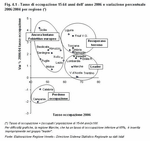 |
| Figure 4.2 |
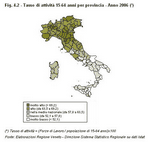 |
| Figure 4.3 |
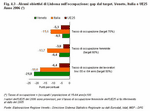 |
| Figure 4.4 |
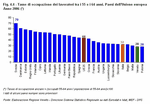 |
| Figure 4.5 |
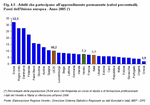 |
| Figure 4.6 |
 |
| Figure 4.7 |
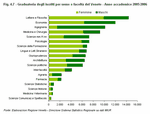 |
| Figure 4.8 |
 |
| Figure 4.9 |
 |
| Figure 4.10 |
 |
| Figure 4.11 |
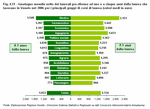 |
| Figure 4.12 |
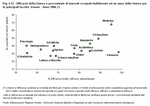 |
| Chapter 4 in figures |
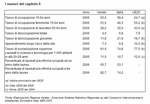 |
|


 Index
Index 












